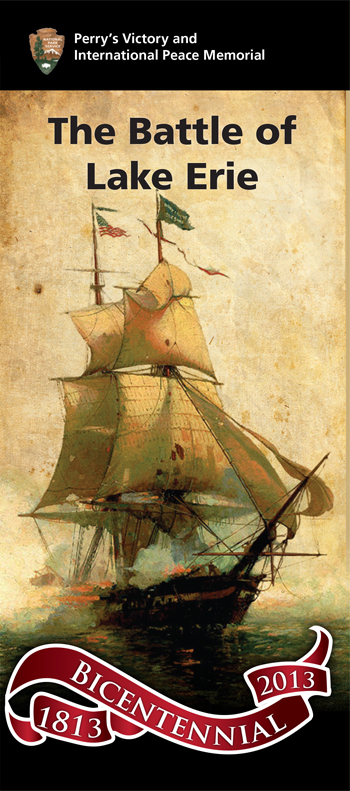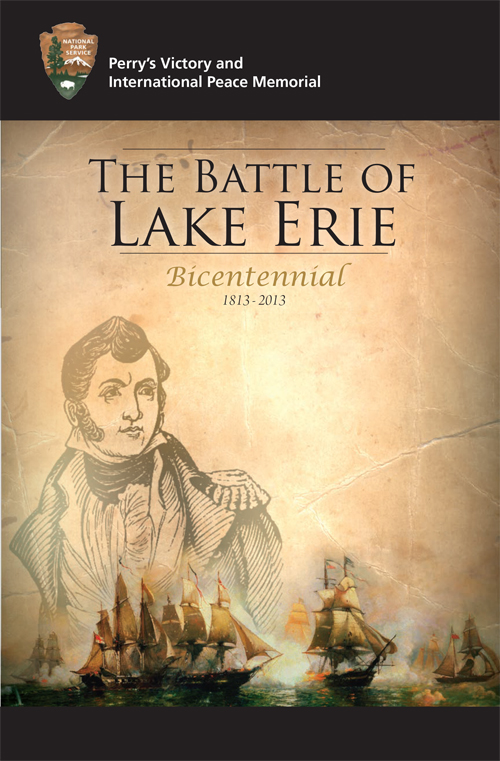|
Perry's Victory & International Peace Memorial Ohio |
 |
 NPS photo | |
... as we gaze on this great monument of stone, erected to the cause of peace, we find renewed hope that eventually nations, like individuals, may learn to sit around the council table and settle their differences without resorting to the bloodshed ...
—Illinois Governor Louis Emmerson, 1931
Rising above Lake Erie, Perry's Victory and International Peace Memorial commemorates the lasting peace between nations once at war—the United States, Great Britain, and Canada. In the decades following the Revolutionary War, the young American republic and the British empire remained uneasy neighbors in North America. This unrest led to a second conflict, "a forgotten war"—the War of 1812—with the British, British Canada, and their American Indian allies. The War of 1812 fixed the northern limit of our nation's frontier, allowed for westward expansion, and drew the outline of our national identity as Americans. Yet there was no clear victor because the 1814 Treaty of Ghent that ended the war put most things back as they were before the war, status quo ante bellum.
The Memorial also honors all who fought and died during the Battle of Lake Erie on September 10, 1813 and the War of 1812. During this inland battle, Commodore Oliver Hazard Perry captured the entire British squadron and raised the now famous "DONT GIVE UP THE SHIP" flag onboard the U.S. Brig Niagara.
This naval battle helped turn a war toward the founding of a lasting peace that today enables close cooperation between the United States and Canada on environmental and other important challenges facing both nations along our mutual border.
"We have met the enemy and they are ours ... "
—Master Commandant Oliver Hazard Perry, 1813
On September 10, 1813, Oliver Hazard Perry scrawled these memorable words on the back of an envelope and sent them to Maj. Gen. William Henry Harrison at the end of a dramatic naval battle on Lake Erie.
Throughout the late summer of 1813, the U.S. Navy's Lake Erie squadron, anchored at Put-in-Bay, effectively cut off British supplies to their forces in the Detroit River valley. The British were now at a crossroads: either retreat and abandon their Indian allies, or strike from their own naval base at Fort Malden/Amherstburg. They chose to attack.
For the young U.S. Navy, this was its first fleet action—and it began badly. The U.S. Brig Lawrence became so disabled after two hours of fighting that Perry abandoned it and boarded its sister ship, Niagara. He then resumed the fight, and in the span of 15 minutes forced a British surrender.
Never before had the Royal Navy suffered the capture of an entire squadron. The Battle of Lake Erie made Oliver Hazard Perry a national hero and gave the United States a much-needed morale boost in the midst of a very unpopular war.
Mapping the War of 1812
British North America In 1812 many residents of upper and lower British Canada were immigrants from the United States. They did not support the war, but as time went on the United States became their enemy. Had the war not happened, they may later have favored annexation by the United States. However, the war rendered annexation unthinkable.
Tecumseh's Indian and British Alliance Shawnee leader Tecumseh sought to create a confederation of Indians ranging from British North America to the Gulf of Mexico. His influence reached from the Creek Indians in Alabama to the Indians in British Canada. They would unite to create a new homeland in the Great Lakes region. The British viewed the potential Indian confederation as a tool for controlling further American expansion.
Master Commandant Oliver Hazard Perry's victory over the British fleet on Lake Erie—an inland naval battle—enabled Harrison's U.S. forces to invade Upper Canada and to defeat the allied forces of Great Britain and the Indian confederacy led by Tecumseh. This victory improved the U.S. bargaining position during treaty negotiations in Ghent, Belgium.
British Blockade Throughout the War of 1812, the British engaged in a naval blockade of all major U.S. ports. Many New England merchants opposed the war, and they smuggled supplies to British troops in North America and Europe. When Napoleon abdicated as the emperor of France in 1814, the Royal Navy extended its blockade northward, crippling the New England economy.
Impressment The rapid expansion of its Royal Navy forced Britain to "press" into service their own citizens and those of the United States and other nations. Unfortunate victims served aboard British warships where they faced hardship, disease, and death.
Battle of New Orleans Gen. Andrew Jackson's resounding victory over the British on January 8, 1815, in New Orleans was the last major battle of the last war ever fought between Great Britain and the United States. The victory preserved America's claim to the Louisiana Territory, prompted a wave of migration and settlement along the Mississippi River, and restored American pride and unity.
Many and Diverse Were They
Some 20 percent of early U.S. naval crews were African American, and Perry's Lake Erie squadron was no different. Black sailors served before, during, and after the war in most U.S. seaports. Desperate for men, Perry sought volunteers from General Harrison's army, and some 130 soldiers volunteered to fight with him. U.S. soldiers, marines, and enslaved men served with former mounted Kentucky riflemen, Yankee sailors from New England, and Pennsylvania, New York, and Virginia militiamen. Many of these landsmen had limited sailing experience, and few had witnessed the horrors of naval warfare.
Tour the Memorial and the Visitor Center
The only international peace memorial in the National Park System was designed by Joseph Freedlander and Alexander Seymor and built by a commission of nine states and the federal government from 1912 to 1915. The remains of three British and three American officers killed during the battle lie under its rotunda.
The Memorial on South Bass Island is reached by ferries from Catawba Point, Port Clinton, and Sandusky from April through November. The Visitor Center is open daily 9 am to 7 pm, Memorial Day to Labor Day, and 10 am to 5 pm the rest of the season. The Visitor Center is closed mid-November to April 1. The Visitor Center is accessible, and service animals are welcome. For regulations about firearms please visit www.nps.gov/pevi.
For your safety please obey all signs and use caution near the seawalls.
Rangers lead programs daily in summer, with musket firing demonstrations on Friday, Saturday, and Sunday.
Source: NPS Brochure (2015)
Brochures ◆ Site Bulletins ◆ Trading Cards

Documents
A Construction History of the Perry's Victory and International Peace Memorial: Volume I (Alfred Mongin, August 10, 1961)
A Construction History of the Perry's Victory and International Peace Memorial: Volume II (Alfred Mongin, August 10, 1961)
Cultural Landscape Report: Perry's Victory and International Peace Memorial (Sherda K. Williams and Susan Calafate Boyle, 1994)
Foundation Document, Perry's Victory and International Peace Memorial, Ohio (October 2012)
Foundation Document Overview, Perry's Victory and International Peace Memorial, Ohio (October 2012)
Great Lakes Junior Ranger Activity Book (Date Unknown; for reference purposes only)
Historic Structure Report: Administrative and Architectural Data, Perry's Victory and International Peace Memorial Column and Plazas (Dalton-Dalton-Little-Newport, December 1976)
Junior Ranger (Ages 6-9), Perry's Victory and International Peace Memorial (Date Unknown; for reference purposes only)
Junior Ranger (Ages 10-12), Perry's Victory and International Peace Memorial (Date Unknown; for reference purposes only)
Long-Range Interpretive Plan, Perry's Victory and International Peace Memorial (October 2011)
National Register of Historic Places Nomination Form
Perry's Victory and International Peace Memorial (Thomas P. Busch, May 28, 1976)
Perry's Victory and International Peace Memorial 1996 Visitor Use Study (David W. Lime, Cynthia A. Warzecha and Jerrilyn L. Thompson, December 1997)
Perry's Victory and International Peace Memorial, The 1993 Park-wide Archeological Survey of South Bass Island, Ottawa County, Ohio Midwest Archeological Center Archeology Report Series No. 8 (Rose E. Pennington, 2015)
The Perry's Victory Centenary: Report of the Perry's Victory Centennial Commission, State of New York (George D. Emerson, comp., 1916)
Perry's Victory and International Peace Memorial at Put-in-Bay
Books

pevi/index.htm
Last Updated: 01-Aug-2024










